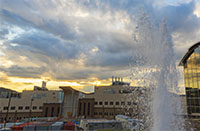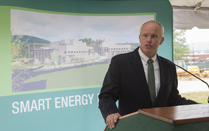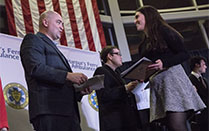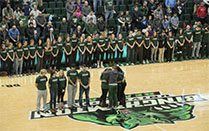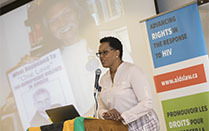Binghamton University President Harvey Stenger's Road Map Quarterly Report - December 31, 2016
As the fall 2016 semester wound down, the campus became very quiet. The majority of students returned home for the winter break, though many of our international students remain. Papers were all turned in, finals were completed and grades are posted. Most of the campus looked forward to a few solid weeks of rest and relaxation before the spring semester begins.
But not every student was hunkered down. Winter Session began right away, with classes starting on Monday, Dec. 19. Around 1,700 students are taking classes over a three-week period, with most courses offered online. This represents an 11 percent increase over last year’s Winter Session numbers. Students will return to campus Jan. 15, with the spring semester beginning Tuesday, Jan. 17. The winter break provides a well-deserved break for our students and I expect that they will return to campus rested, relaxed and raring to go.
Even as the campus prepared for finals, we were devastated to learn of the death of one of our students. Junior Stephanie Lineva, one of our star student-athletes, was struck and killed in a hit-and-run accident on the Vestal Parkway Saturday, Dec. 3. Stephanie was a transfer from Adelphi University and a resident of Queens, N.Y. She was a highly regarded member of the women’s tennis team, a bright and engaged student; the campus was stunned by her death. I, along with members of the administration, especially from Student Affairs, have been in touch with the family. Students who knew her were provided counseling if they desired, and campus police and other offices provided support for the investigation.
The Binghamton University Foundation immediately stepped forward with a $5,000 reward to help find the driver, which was matched by the City of Binghamton. Several other local businesses and individuals added to the fund, which eventually totaled over $30,000. A suspect was arrested shortly after the reward was announced. We are now looking for ways to educate our students about being safe off campus and will be working with student groups to promote safe behaviors.
The Role of the Foundation
The Binghamton University Foundation plays an important role on campus. While we are grateful for the role it played in providing the reward in this case, its normal function is to serve as the steward of the charitable gifts that are given to the University. The largest part of these are distributed as student scholarships. This year the Foundation set a record, providing nearly 2,000 scholarships, fellowships and grants to Binghamton University students, valued at $2.8 million. This is a remarkable achievement that benefits our students and the University in many ways — enhancing student access, diversifying the campus and adding to our academic reputation.
The impact of this support was evident in October when the University held three different events honoring our donors — our traditional donor scholarship recipient gathering, as well as two separate events recognizing the support provided by Sodexo and Barnes & Noble, respectively. These are always great meetings where the collective power of Foundation support is on display. In addition, the University celebrated several other gifts from alumni — we had an anonymous donation of $2.2 million that is supporting a significant upgrade to our baseball field. It’s the largest gift ever given to Binghamton Athletics and is funding a field turf synthetic surface and new lighting for our baseball facilities. The upgraded field will be much more weather resilient, so that our team will be able to begin outdoor practice earlier and games will be less likely to be postponed or canceled.
We also recognized the generous academic support provided by alumni Jay ’74 and Jeanne Benet. The Benets have been longtime supporters of the University and have given generously to support faculty development, our new data analytics academic program and the Harpur Fellows program. In addition, Jay has served on the Harpur Advisory Council, supported externships for Harpur students and served as a liaison for our development team with fellow alumni. Given this record of support, earlier this month we named the Jay S. and Jeanne Benet Alumni Lounge, located in the Alumni Center, in their honor.
Grad Study Lounge
Just as we are working to enhance facilities for our alumni supporters, so too are we improving spaces for our current students. For example, we recently added a new graduate group study space in Bartle Library. This new room is the result of conversations that began nearly two years ago with leaders of the University’s Graduate Student Organization. They approached the administration about the need for a dedicated space for group research by graduate students, much like the Library Commons and other spaces serve for undergraduates.
This space and its purposes reflect changes in the way graduate education is conducted. Graduate study today is one of interconnectedness — not just in terms of online access, but in terms of working with peers and colleagues on group projects that benefit from the collective intelligence and insight that a diverse set of individuals bring to any challenge. Today, graduate students are often found working with peers from other disciplines and departments as they brainstorm solutions to the challenges that confront us. As a University, our goal is to help them in these efforts — and part of that means giving them a bright, comfortable space with the tools they need — computer work stations, large tables for group projects and comfortable seating that encourages discussion and interaction. This new space will help us attract graduate students, raising our profile and strengthening our reputation as a place that recognizes and meets the concerns of our advanced students.
Support for campus and regional development from the governor’s office
Of course, the University’s largest current Initiative, the development of a new Health Sciences and Technology Innovation campus, anchored by our new School of Pharmacy and Pharmaceutical Sciences (SOPPS), will also help us attract advanced students and strengthen our graduate programs. Construction of the new facility is moving along on schedule, and we were pleased to have Gov. Andrew Cuomo visit the Johnson City site in November to participate in the traditional beam-signing that marks the topping-off of the structural steel phase of construction. He was joined by a host of local and state political leaders, including Sen. Fred Akshar and Assemblywoman Donna Lupardo, so it presented a good opportunity for the University to highlight its economic impact and our vision for the future.
Our SOPPS is progressing in in other ways as well. In mid-December, the University was informed that the New York State Board of Regents, which oversees the NYS Department of Education, authorized the University to award the Doctor of Pharmacy degree
This approval of the PharmD degree indicates that the NYS Education Department has completed a professional review of the program and found it in compliance with NYS standards for professional degrees. In addition, we expect that the school will be awarded Precandidate status from the Accreditation Council for Pharmacy Education in January. The next step will see the State Education Department register the program, which will then allow us to recruit students and open the program, with the first class matriculating in fall 2017.
But the big news during Cuomo’s visit was his announcement that the state would authorize funding for the next phase of our Health Sciences and Technology Innovation Park at the site in Johnson City. The state will be providing $21 million in Upstate Revitalization Initiative (URI) funding to renovate the former shoebox factory at 48 Corliss St., adjacent to the SOPPS facility, to collocate the Decker School of Nursing. All told, when the two schools move into their new home, over 1,000 faculty, staff and students will be working, shopping, eating and living in the area each day.
In his remarks, the governor emphasized the role that the University is playing in economic development in the region, and stressed that the partnership between government, education and private industry are vital to the economic growth in the upstate region. This model has been the centerpiece of both the Regional Economic Development Councils (REDC) and the URI, which, together, have brought more than $900 million in state support to the region.
In December, I was in Albany for the announcement of the Round VI REDC Awards, which, on the whole, were smaller than in previous years. A total of $700 million was distributed to the 10 REDC districts, so we were not surprised that the Southern Tier received $60.4 million for 63 projects. While this is slightly less than most of the other districts received, it’s important to keep it in perspective — the region has been a top awardee in four of the previous rounds and received a $500 million URI grant last year.
Many of the projects being funded in this round are important to the region, but only one directly affects the University — we received $125,000 to support the development of the Binghamton University business incubator. This incubator will consist of wet labs, dry labs, public and collaboration spaces, and a co-working space. The layout of the space is designed to increase the collaboration among tenants, visitors and staff.
Lt. Gov. Kathy Hochul was on campus several times over the past month to discuss economic development issues and other issues related to the region’s growth. In November, she announced the winners of a clean energy competition among start-up companies in the Southern Tier. The competition offers $20 million in prize money and support services, including a $1 million top prize. Two start-up firms associated with Binghamton University received awards — ChromaNanotech, a company that produces a dye that blocks invisible radiation in windows to reduce air conditioning loads, received $250,000 in grants to develop their product, while Charge CCCV (C4V), a firm that produces energy storage batteries with longer lifetimes for telecommunications systems and other industries, received $500,000. These are two companies that have innovative products that could help place the Southern Tier — and Binghamton University — on the map for clean energy.
Hochul returned to campus in mid-December to announce $2.8 million in NYSUNY 2020 awards for Binghamton University to support the development of a state-of-the-art renewable energy research and development facility. The facility, which includes a “dry room” housed in the Center of Excellence Building (COE) at Binghamton, will promote energy efficiency by testing current research efforts that focus on battery life maximization. These funds will help us equip and staff the facility that was made possible through a $600,000 REDC grant last year. The dry room fills a crucial research need — the chemicals used in batteries require very dry conditions and will help place the University’s Northeast Center for Chemical Energy Storage (NECCES) at the forefront of battery research and development. The grant also links the campus with other SUNY research centers, with Binghamton serving as the hub of the energy research enterprise.
And then in late December, Hochul returned to campus to oversee a conference on sustainability and regional development that was hosted by the governor’s office. In my welcoming remarks, I had the opportunity to highlight the University’s commitment to sustainability — emphasizing our Sierra Club and Princeton Review “green” rankings, the 650 tons of material we recycled last year, how our food services source locally and support composting, and our commitment to sustainable design and construction in our facilities. I also remarked on the way sustainability is part of the educational and research mission — with a one-of-a kind master’s program in sustainable communities, a Transdisciplinary Area of Excellence (TAE) in sustainable communities, and major research initiatives that focus on reducing energy use in computing and alternative energy sources.
Samakkia appointed Interim President for SUNY Polytechnic
One of the reasons for Binghamton’s growing reputation for research in sustainability and related fields has been the expertise and experience of our vice president for research, Bahgat Sammakia. In addition to his work as vice president, Sammakia has also served as the director of our Center of Excellence in Small Scale Systems Integration and Packaging (S3IP) in which much of our alternative energy, battery and energy-optimization research is conducted. As an indication of the respect he has gained throughout the SUNY System, Sammakia has been named interim president of SUNY Polytechnic Institute, beginning in December. This will be a challenging assignment for him, but I am confident that he will do very well and that his appointment will help that campus significantly. We are already looking forward to seeing him return a year from now.
Election message
The nation, as well as our campus, was very interested in the outcome of the national election in November, with emotions running high on all sides. Here on campus, student voting set records, and many student organizations participated in get-out-the-vote activities in the weeks leading up to election day.
Unfortunately, these emotions have continued in the days and weeks following the vote, with reports of intimidating messages and actions at other campuses. These acts have disproportionately targeted individuals who are immigrants, Muslim, LGBTQ or minorities. Fortunately, we’ve not had any similar situations on our campus, but I felt it important to respond proactively.
Toward this goal, I sent out a notice to students on Veteran’s Day recognizing those who have served in the military forces and the role they played safeguarding our values and rights, especially the right to vote and protection of free speech. I emphasized the way our educational and research missions support civil society, and that these missions require respectful conversations. So I was sympathetic when a number of faculty and students expressed concern about the current climate and its impact on their ability to teach and learn.
In light of these concerns, Provost Donald Nieman, Chief Diversity Officer Valarie Hampton and I worked to restate the University’s commitment to diversity and free speech. Our goal was to avoid partisanship, while recognizing the intensity of emotions around the election.
With this in mind, we released a second statement reiterating our call to members of the campus community to listen to each other with respect and civility, as these are central to the pursuit of knowledge. But just as importantly, I wanted to stay in touch with the concerns of students, faculty and staff. In our statement, I called on the University community to keep me informed and provided a list of resources to which anyone concerned about their safety can report any incidents of intimidation.
In this regard, I am most concerned about the status of our minority and international students. There have been reports in the media that some international students at other campuses have faced hostility, and many are concerned about their status under the new administration. In late December, I submitted an essay to the Binghamton Press & Sun Bulletin highlighting the economic, social and cultural impact that our 2,700 international students have in our region and calling on the community to support and, if need be, protect our students. I also shared this message in several of my meetings with local leaders and with members of the Binghamton University Forum.
Harpur’s Ferry recognition
One of the organizations most responsible for keeping students safe on campus is Harpur’s Ferry, the University’s award-winning, student-run team of Emergency Medical Technicians.
Earlier this month, Harpur’s Ferry held a special ceremony to honor the first-responders who were responsible for saving the lives of two members of the University community earlier this semester. Both individuals suffered cardiac arrest events in separate incidents. To understand just how effective our volunteers and police were during these events, it’s worth noting that survival rates for individuals experiencing cardiac arrest is less than 10 percent. But the fact is, Harpur’s Ferry is far better than average, and because of its members’ commitment, the community at Binghamton University is safer and healthier than we would be without them.
Parking and winter issues
With winter now upon us, students and faculty have expressed more concerns about parking and winter travel to and on campus, including the way in which campus closures are determined. The issue of campus parking has become increasingly challenging, particularly as we’ve increased both student enrollment and the size of the faculty in recent years. In November, I sent out a message to the campus indicating that we are working to address this, with the goal of increasing parking by 10 to 15 percent within the next year.
Our Transportation and Parking Services Office has conducted an intensive study of the issue and found that parking is especially difficult at midday, with very few open spots in the lots closest to the center of campus. To alleviate this problem, we will be constructing a new parking lot off Bartle Drive, near the Information Booth, with the goal of adding at least 200 spots in time for the start of the fall semester. We may add additional parking in later phases. We also are working to free up spots that are occupied by state and maintenance vehicles, as well as looking to find ways to enhance the campus shuttle system and encourage carpooling. In the long-term, issues of campus parking will be partially solved by the addition of new campus facilities in Johnson City as well as the opening of our new facilities at the Innovative Technologies Complex.
My message also addressed the traffic jams that are occurring at peak hours as people enter or exit the campus, currently exacerbated by the year-long closing to traffic of the stretch of Old Vestal Road opposite the campus. We are working with the DOT, Town of Vestal and Broome County officials to find ways to optimize timing of traffic lights, which we think will help reduce this problem.
In addition, I explained the complex deliberations that go into closing the campus when it snows. The decision to open or close is one that weighs many factors — the condition of the roads, the intensity and duration of the storm and the manpower on hand to meet the storm’s challenges — all weighed against the significant financial and educational cost that closing the campus brings. I work closely with my Emergency Management team, as well as transportation, physical facilities and public safety, gauging their best estimates of whether the campus should open or not. I even personnally tour the campus and surrounding towns hours before classes are due to begin. I also follow closely what other institutions in the region are doing — but ultimately, it’s my decision, though perhaps it’s colored by my time working in Buffalo.
Road Map Renewal
Although I may make the final call on things like snow days, I value the judgment and input that the University community can offer. This has been the guiding principle behind our Road Map, which has produced nearly 100 initiatives and proposals since it was implemented in 2013. Over the past semester, the Road Map Steering Committee, with input from the Faculty Senate Budget Review Committee, identified a total of 10 proposals that merit funding as part of the Road Map 2017-18 allocations. In addition, we’ve identified 17 more proposals that will receive some level of funding from divisional operations budgets.
Proposals that will be funded by $2 million in Road Map funds include:
• An increase in internet capacity for the campus
• A feasibility study for our next comprehensive gifts campaign
• Science 5 research infrastructure enhancements
• Upgrades for our student Public Speaking Lab
• Development of a Smart Laboratory for our Freshman Research Initiative
We are in the last year of our current Road Map budget formula, so most of the money available has been allotted on a one-time basis, with less money overall to support promising proposals. Thus, the divisions have opted to fund several important initiatives out of their existing operations budgets.
Among the proposals that will be funded from the divisions are:
• Support for instrumentation for the Health Sciences Core Facility
• An upgrade of the sound system in Watters Theater
• A technology security operations center for our IT operations
• Renovation of space for our Employee Assistance Program
We also will be setting aside some resources to help the campus coordinate University-led initiatives as part of the URI and REDC.
As important as these initiatives are, the campus is now at a turning point. The higher education environment is changing, with changes in policy likely in Washington and a different fiscal outlook in Albany. But it is important that the University continue to move forward and build on the achievements of the past four years. For this reason, I’ve reconvened the Road Map Teams for a Road Map Renewal.
The Renewal kicked off Dec. 8, at the very time I was in Albany for the REDC announcements, so I touched base with the Road Map teams via Skype. We also had a recorded statement about the Renewal — and I think my message came across loud and clear.
Significantly, the team is nearly as large — about 350 faculty, staff, students and community members — as the original Road Map Team. This shows that the campus is still very engaged in making the campus not just better — but premier.
The Renewal will build of the existing structure and processes of the Road Map — we’ve seen how effective they are — but we are looking for activities and initiatives that will move the campus forward in a time of change — changing resources, changing policies and changing priorities. With these limits in mind, we are looking to identify collaborative projects that will leverage our resources and have a broad impact on the University community.
Teams have been organized around our five strategic priorities and we will be working under a tight timeline — I want to have proposals and initiatives in hand by the end of April. This is just 10 short weeks, so there’s a lot that we need to do.
I can’t wait to see what the campus dreams up.
So, as the fall semester has ended, I want to thank the University community for everything it has done for the campus this year. Despite the occasional setback and, especially an untimely tragedy, the campus remains on good footing, with significant progress in every one of our strategic priorities. I hope that all of us have had a happy and restful holiday season and are returning to campus with energy and new ideas.
Sincerely,

Harvey G. Stenger

